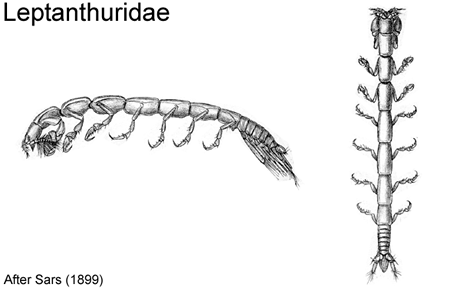 |
||||||
|
|
|
|
|
|
Australian Isopoda: FamiliesS.J. Keable, G.C.B. Poore & G.D.F. WilsonLeptanthuridae Poore, 2001 Leptanthuridae Poore, 2001a: 133. Description. Body. Body shape without loss or gross modification of appendages on one side of the body; in dorsal view without peduncular articles of antenna 1 or 2 contiguous with coxal margins. Head. Head not capable of lateral rotation (laterally encompassed, abutting or fused to pereonite 1). Antenna 1 inserting on head anteriorly and/or dorsally to antenna 2, minute or well developed; not as follows: reduced to 2 articles with second article expanded and scalloped. Antenna 2 well developed; flagellum of fewer than 10 articles, shorter than peduncle, or of numerous articles, longer than or shorter than peduncle. Mouthparts not forming suctorial cone or proboscis; acutely produced anteriorly. Mandible not projecting anteriorly and together forceps-like; with acute anteriorly-directed incisor; palp present, or absent. Maxilliped palp narrow, tapering to acute apex, of fewer than 4 articles (c. 3 times as long as wide), with 5 free articles (rarely) or with 2 or more articles fused; endite reaching palp article 3 or absent or obsolete. Pereon. Pereonites 6-7 pereonite 7 distinct dorsally, free. Pereonite 7 wider than long, much shorter than pereonite 6 (body 10-15 times as long as wide, females and juveniles rarely more elongate). Pereopods 6-7 pairs readily apparent; 1-3 or 1-7 not prehensile. Pereopod 1 propodal palm defined proximally by angle or proximal tooth, with even marginal row of short complex robust setae along length or with even marginal row of closely-set simple robust setae. Pereopods 2-3 carpus not or weakly produced posterodistally; propodus with more than 1 robust setae in addition to posterodistal robust seta. Pereopods 4-7 propodus with more than 1 robust setae in addition to posterodistal robust seta. Pereopods 5-7 without flattened setose articles andor dactyls modified or absent. Pereopod 7 propodus anterodistal serrate setae absent. Pleon / Pleotelson. Pleonites 1-5 free and articulating, or fused; together 2 times as long as wide (or less). Pleonites 4-5 without plumose setae on pleonal epimera or posterior borders. Pleopods 5 pairs present; with pleopod 1 exopod opercular alone. Pleopod 2 of males not consisting of an enlarged peduncle with a geniculate endopod and a small muscular exopod. Pleotelson statocyst single. Uropods positioned proximally on pleotelson; distinct from pleopods, not forming operculum over pleopodal chamber (although may be folded ventrally below pleotelson). Peduncle not forming an elongate clavate article with rami reduced or absent. Endopod not claw-like (acute and recurved) andor posteroventral in position. Exopod folded dorsally over pleotelson. Distribution and generic composition. See Kensley et al. (1996).
Cite this publication as: 'S.J. Keable, G.C.B. Poore & G.D.F. Wilson (2002 onwards). 'Australian Isopoda: Families. Version: 2 October 2002. https://crustacea.net'. |
|
|
|
|
|
|
|
|
|
Copyright © Australian Museum, 2002 - 2003
Australian Museum website
